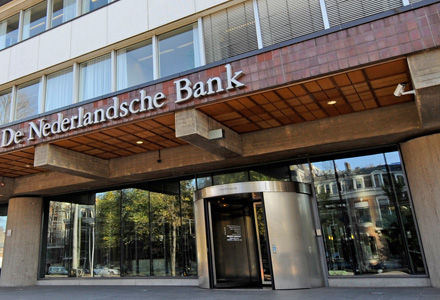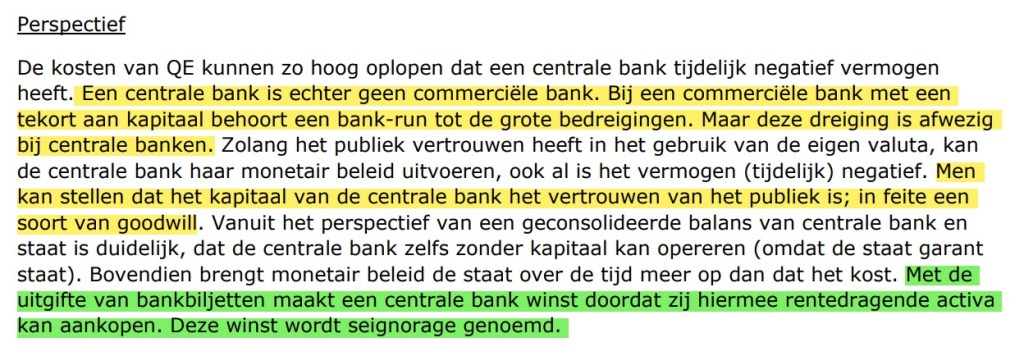
De Nederlandsche Bank
Net zoals de Nationale Bank van België een volledig geïntegreerd onderdeel van het Europees Stelsel van Centrale Banken (ESCB).
More importantly, a central bank has a monopoly of the issuance of banknotes, which are liabilities that bear no interest rate. Against these liabilities the central bank invests in assets with positive expected returns. We refer to this collectively as the central bank seigniorage income and this explains why central banks generally make profits. (..)
However, the amount of seigniorage income is uncertain and depends on the applicable monetary policy in place. In adverce scenarios – and if monetary policy demands it – seigniorage may be low for a long time or even negative for a number of years. Therefore, seigniorage does not help to ensure independence ans credibility over the medium term.

Voor elkeen die werkelijk inzicht wil krijgen in het hoe en waarom van een centrale bank …

4. The risk exposures of a central bank:
4.1 Financial risks: (..) The liabilities are largely in the hands of the public (banknotes) and commercial banks (deposits). Capital is the shareholder equity on the balance sheet which is available for absorbing losses.
In addition to credit risk, market risk and exchange rate risk, a central bank also faces interest rate risk from the mismatch between assets and liabilities. The values of both assets and liabilities are sensitive to changes in interest rates.
This interest rate risk is greater the more the duration of assets deviates from the duration of liabilities. Currently, for many central banks, the duration of assets is longer than that of the liabilities. Such a positive duration gap means that the central bank suffers a loss if interest rates rise.
Historically, however, many central banks typically had a negative duration gap, caused by a duration of assets that was lower than the duration of liabilities because the liability side of the balance sheet was dominated by the banknotes in circulation, with a long duration and no coupons.13
In recent years, interest rate risk has become a more prominent risk factor for a number of central banks. For these central banks, policy rates have decreased to levels close to or below zero, leading to lower profitability. At the same time, balance sheets have surged due to QE programmes. In such cases, the duration gap has reversed from negative to positive as the long maturities of the QE portfolios exceed the duration of banknotes and deposits on the liability side. For these central banks, years of significant annual losses may occur when the policy interest rates rise quickly and substantially. The Dutch central bank (DNB) is one of the central banks where interest rate risk constitutes a large part of the risk profile.
Met de volgende voetnoot, ter info:
The most basic interpretation of the duration of banknotes is that it is undefined. Banknotes have no explicit maturity nor coupons. There are, however, other ways to consider the duration of banknotes.
First, consumers have the option to exchange banknotes for a deposit at the bank at any given time. This creates a finite duration of banknotes. Second, a country or a central bank has the option to stop circulating banknotes and move to a cashless society. Again this option creates a finite maturity of banknotes. Third, banknotes are regularly taken out of circulation because of damage. Although this creates a finite maturity of a single banknote, it does not change the duration of banknotes as such because the damaged banknote will be replaced by another one

In onderstaand eindrapport neemt DNB een “Begrippenlijst” op. Wat dient men te verstaan onder het begrip ‘de seigneuriage’ van een Nationale Centrale Bank ?
Het eindrapport werd publiek gemaakt op 4 december 2023, en kan inzake inhoud heel moeilijk als “achterhaald” worden beschouwd.

Het eigen vermogen is het vertrouwen in de centrale bank, de ‘seigneuriage’ is de winst verkregen door de uitgifte van renteloze bankbiljetten …

Het via het emissiemonopolie van het wettelijk betaalmiddel verkregen voordeel: de uitgifte van bankbiljetten in euro, als een financieringsmiddel zonder rentevergoeding noch renterisico.
In de “Begrippenlijst” stelt men “renteloze passiva – in het bijzonder bankbiljetten”, omdat de ECB en de NCB’s ook de macht hebben om de commerciële banken reserveverplichtingen op te leggen waaraan zij eveneens geen rentevergoeding kunnen aan toekennen. Op dat moment kunnen ook de opbrengsten uit de beleggingen die de tegenpost zijn van die reserveverplichtingen worden beschouwd als ‘seigneuriage’.

Wanneer de Nederlandsche Bank de financiële schade opmeet en in een rapport vastlegt op welke manier men het beste handelt om uit de situatie van negatief eigen vermogen te raken zonder het vertrouwen in de centrale bank te verliezen, stelt men terecht het belang van het financieringsvoordeel van de bankbiljetten (als miljarden euro’s gratis werkmiddelen) voorop.

dE SYNTHESE, ook van de Nederlandsche Bank:
De Nationale Centrale Banken hebben een emissiemonopolie van het wettelijk betaalmiddel verkregen. Dankzij dat verkregen monopolie beschikken zij over een bankbiljettenomloop in euro, werkmiddelen waarover zij geen rente moeten vergoeden en waarover zij geen renterisico lopen.
Naast de bankbiljettenomloop financieren de centrale banken hun opdrachten (van algemeen belang) en andere taken via centrale bankreserves en deposito’s. Werkmiddelen waarover zij wel een rentevergoeding toekennen, en wel een renterisico lopen.